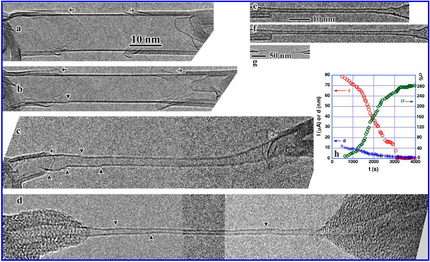Scientists stretch carbon nanotubes at high temperature

Physicists at Boston College have for the first time shown that carbon nanotubes can be stretched at high temperature to nearly four times their original length, a finding that could have implications for future semiconductor design as well as in the development of new nanocomposites.
Single-walled carbon nanotubes are tiny cylinders thousands of times smaller than the width of a human hair but many times stronger than steel. The cylinders, which consist of carbon atoms interlinked in a hexagonal pattern, have novel properties that make them potentially useful in a wide range of applications.
At normal temperatures, carbon nanotubes snap when stretched to about 1.15 times their original length. But in a paper published in the Jan. 19, 2006, issue of the journal Nature, a team of physicists led by Boston College Research Associate Professor Jianyu Huang showed that at high temperatures nanotubes become extremely ductile. When heated to more than 2,000 degrees Celsius, one was stretched from 24 nanometres to 91 nanometres in length before it snapped.
The elongation was done by applying an electric current to the nanotube, which created a high temperature within the tiny structure and enabled the scientists to pull it like salt water taffy. Huang and his colleagues said their research indicates that nanotubes may be useful in strengthening ceramics and other nanocomposites at high temperatures.
At room temperature, a nanotube typically conducts electrons like a metal. But Huang said his team observed that when stretched under high temperature, a nanotube acts less like a metal and more like a semiconductor as the level of electrical current flowing through the structure falls. Huang said that raises the possibility that superplastic nanotubes could be used in developing new generations of computer chips.
Huang credited Boston College PhD student Shuo Chen with devising a special microscopic probe that allowed researchers to grab one end of the nanotube and stretch it while an electric current flowed through it. Other members of the team included Boston College physics faculty Zhifeng Ren, Ziqiang Wang and Kris Kempa; Boston College postdoctoral fellow Sung-Ho Jo; and professors Gang Chen and Mildred Dresselhaus at the Massachusetts Institute of Technology and Dr. Morris Wang at the Lawrence Livermore National Laboratory in California.
Source: Boston College t

















